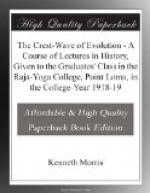Under Asoka, Chandragupta’s grandson, the age culminated. H. P. Blavatsky says positively that he was born into Buddhism; this is not the general view; but one finds nothing in his edicts, really, to contradict it. His father Bindusara, of whom we know nothing, may have been a Buddhist. But it would appear that Asoka in his youth was the most capable, and also the most violent and passionate of Bindusara’s sons. During his father’s lifetime, he held one of the great vice-royalties into which the empire was divided; he succeeded to the throne in 271. His domains at that time included all Aryavarta, with Baluchistan, and as much of Afghanistan as lies south of the Hindoo Koosh; and how much of the Deccan it is difficult to determine. Nine years later he extended this realm still further, by the conquest of the Kalingas, whose country lay along the coast northward from Madras. At the end of that war he was master of all India north of a line drawn from Pondicherry to Cannanore in the south; while the tip of the Deccan and Ceylon lay at least within his sphere of influence.
He was easily the strongest monarch of his day. In China—between which country and India there was no communication: they had not discovered each other, or they had lost sight of each other for ages—an old order was breaking to pieces, and all was weakness and decay. In the West, Greek civilization was in decadence, with the successors of Alexander engaged in profitless squabbles. Rome, a power only in Italy, was about to begin her long struggle with Carthage; overseas nobody minded her. The Crest-Wave was in India, the strongest power and most vigorous civilization, so far as we can tell, in the world, and at the head of India stood this Chakravartin, victorious Asoka, flushed with conquest, and a whole world tempting him out to conquer.—
He never went to war again. For twenty-nine years after that conquest of the Kalingas, until his death in 233, he reigned in unbroken peace. He left his heart to posterity in many edicts and inscriptions cut on rocks and pillars; thirty-five of these remain, or have so far been discovered and read. In 257, or five years after the Kalinga War, he published this:
“Devanamipiya Piadasi”—
It means literally ’the Beloved of the Gods, the Beautiful of Countenance’; but it is really a title equivalent to “His Gracious Majesty,’ and was borne by all the Maurya kings;—
“Devanampiya Piadasi feels remorse on account of the conquest of the Kalingas; because, during the subjugation of a preciously unconquered country slaughter, death, and taking away captives of the people necessarily occur; whereat His Majesty feels profound sorrow and regret...”
It would be in keeping with the Southern Buddhist tradition as to the ungovernable violence of Asoka’s youth, that he should have introduced into war horrors quite contrary to Manu and Indian custom; but here I must say that H. P. Blavatsky, though she does not particularize, says that there were really two Asokas, two ‘Devanampiya Piadasis,’ the first of whom was Chandragupta himself, from whose life the tradition of the youthful violence may have been drawn; and there remains the possibility that this Kalinga War was waged by Chandragupta, not Asoka; and that it was he who made this edict, felt the remorse, and became a Buddhist. However, to continue (tentatively):—




